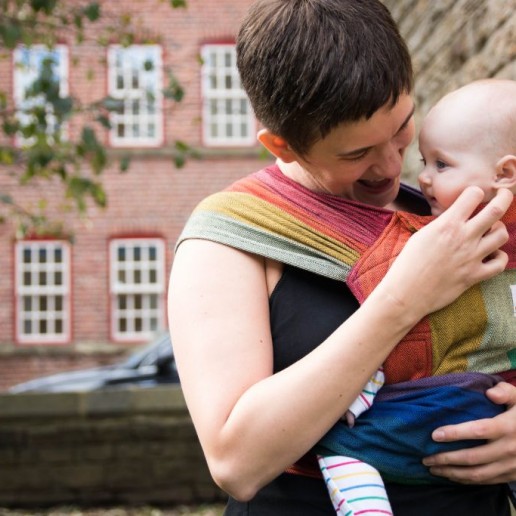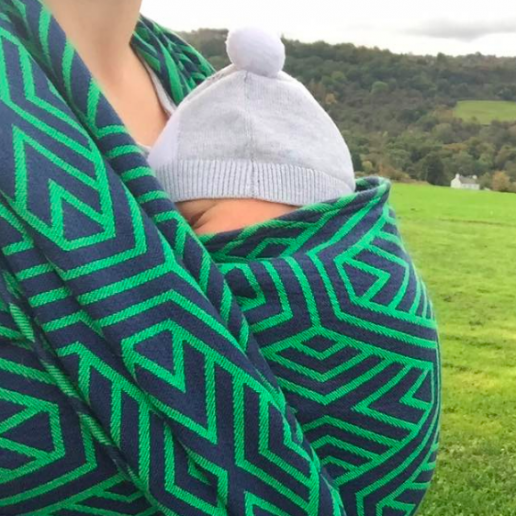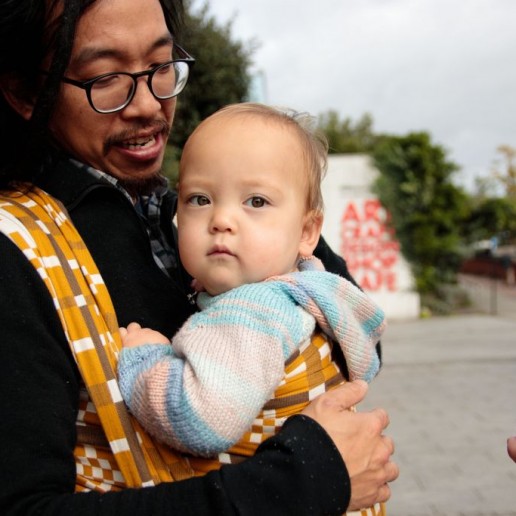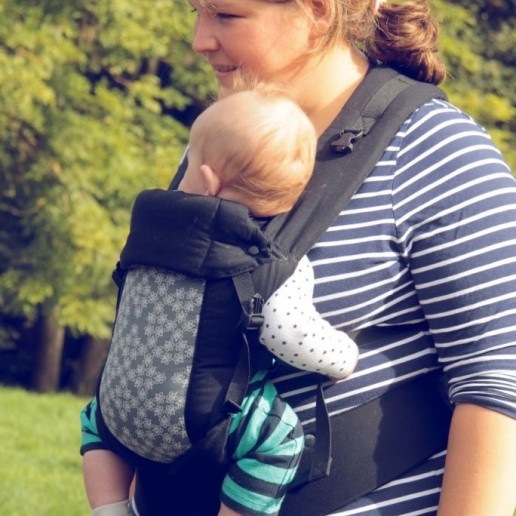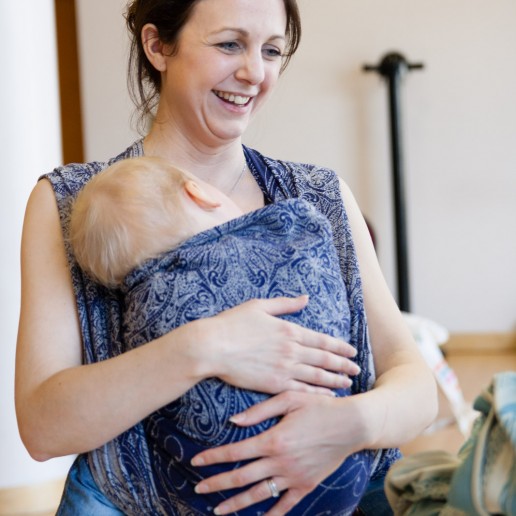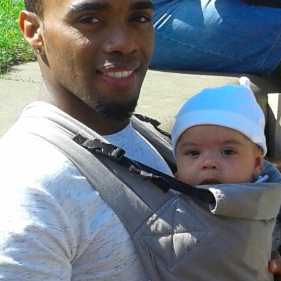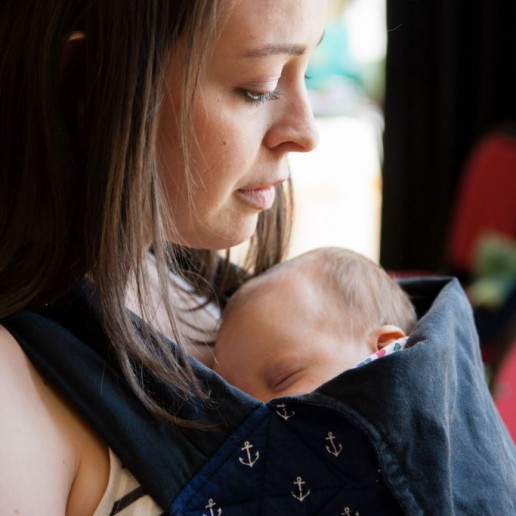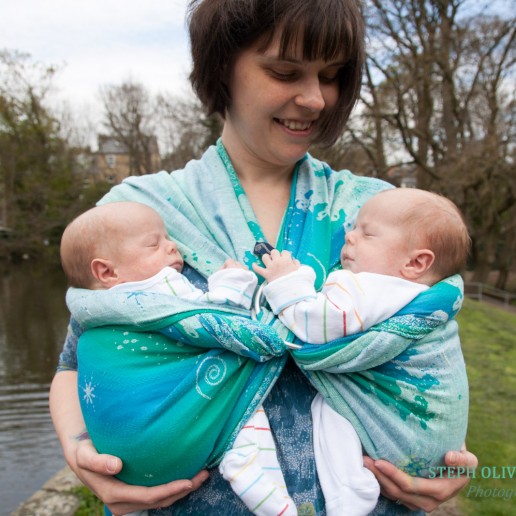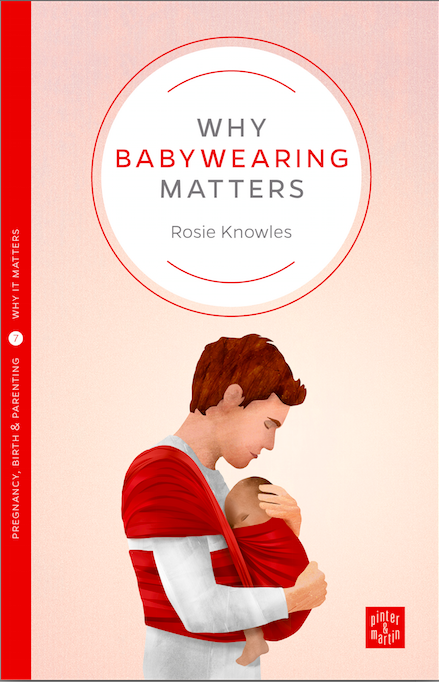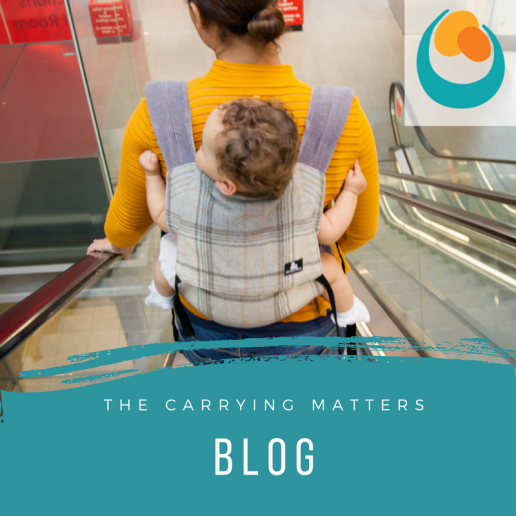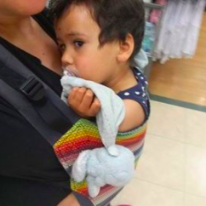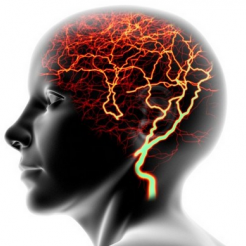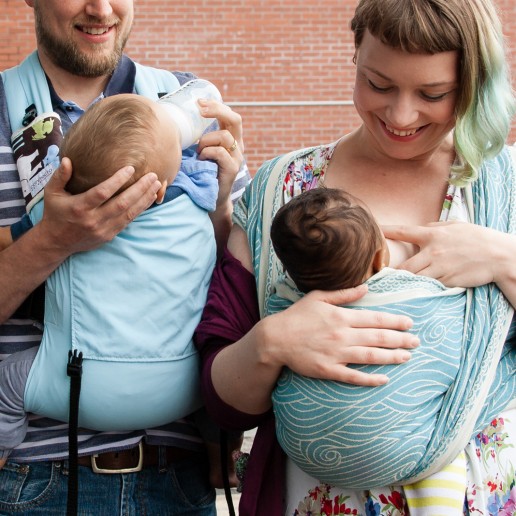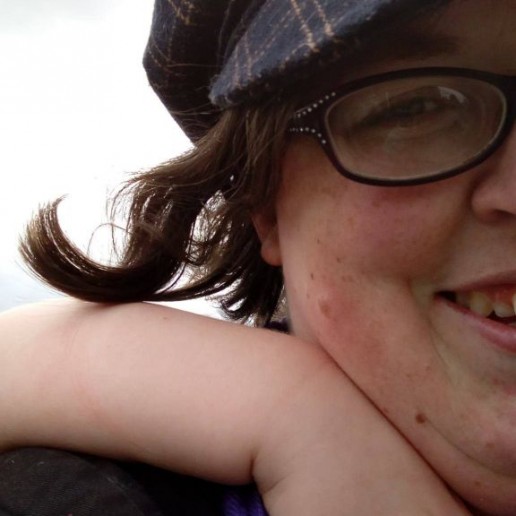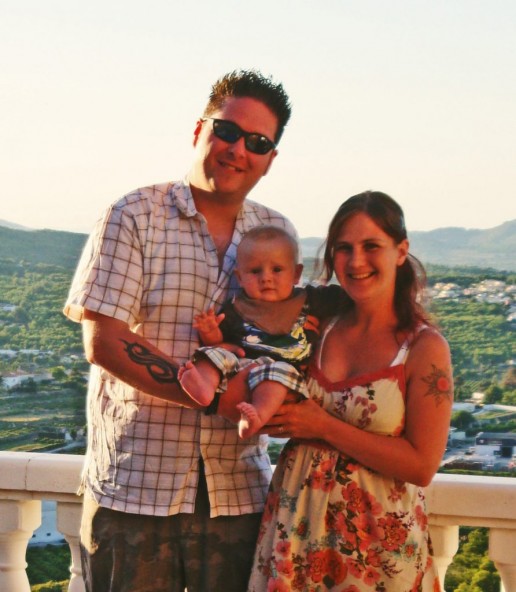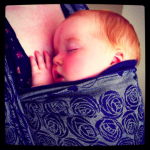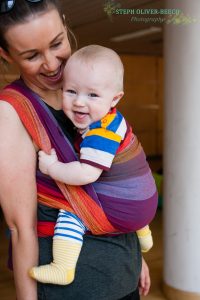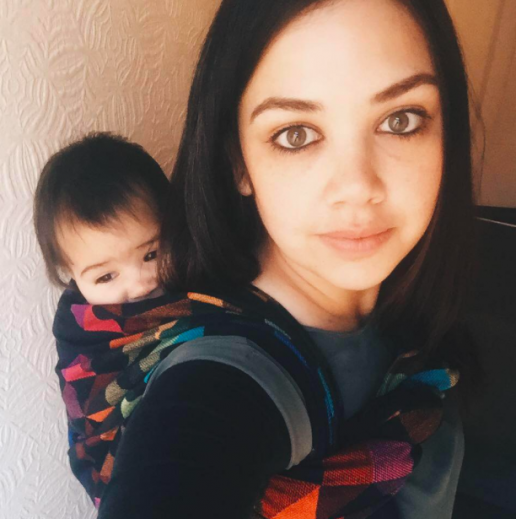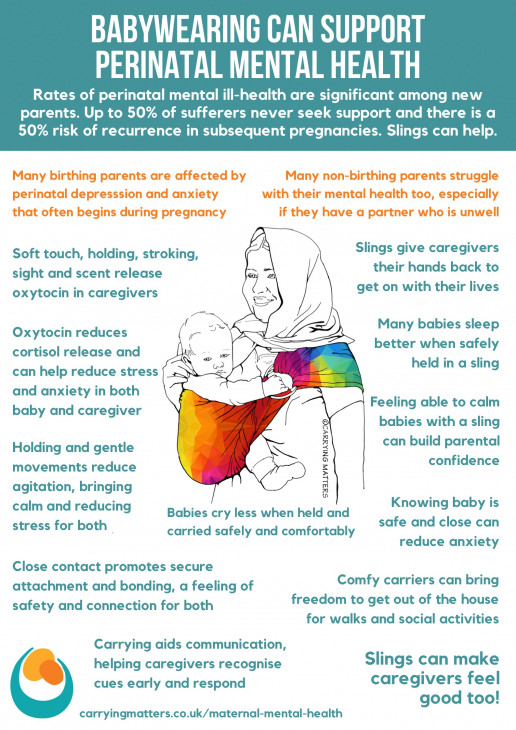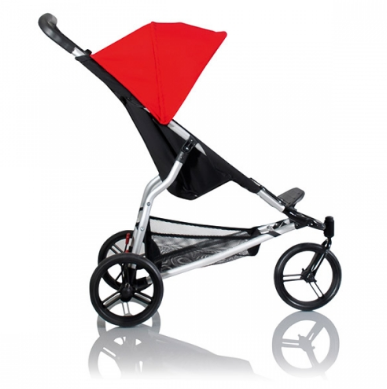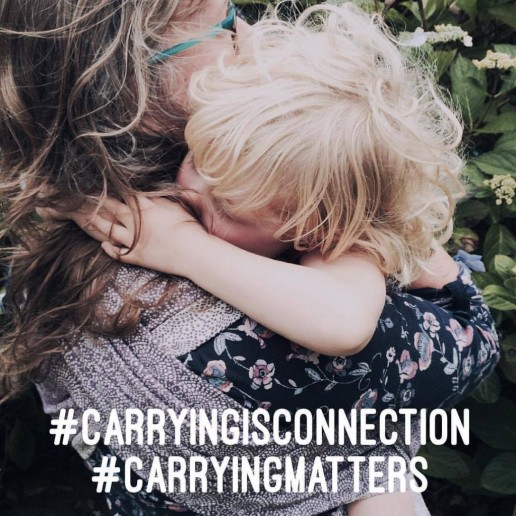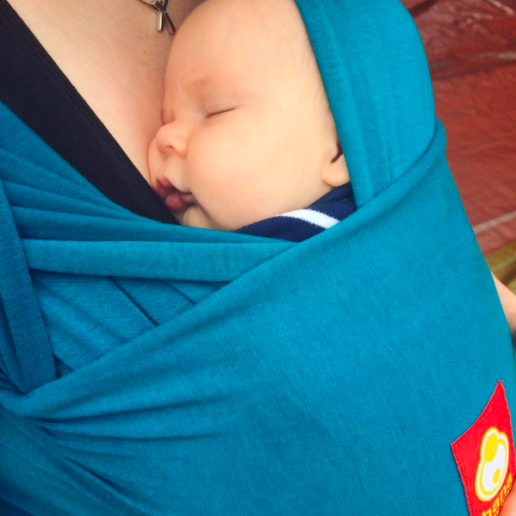Positive Effects of Carrying for Society
The positive effects of carrying for society are many; making a change at an individual level can have a significant impact when lots of people do it! In-arms carrying and using slings is one way that we can change the future that we all have to live in.
Possibly one of the most important positive outcomes for carrying for a parent and the society we live in is the effect it can have on mental health, which is a society-wide issue.
Western society is increasingly fractured and isolated, with a decreased sense of local community and shared care. The burden of mental unwellness in our society is growing, and becoming a parent with this background can be very tough indeed.
The birth of a baby is often an overwhelming time for both parents, especially when also faced with the expectations and demands of a fast-paced culture that often judges people by their apparent productivity and appearance. It is no wonder that postnatal depression is on the rise – affecting at least 10-15% of new mothers. This is likely an underestimate as parents feel ashamed to admit their feelings, with the effects of hiding their struggle having significant knock-ons for the whole family.
Fathers are often unrecognised to have the condition themselves, and this all adds to an increased risk of children coming to harm. This is a terrible indictment on our culture and its lack of care for some of the most vulnerable individuals in our communities.
The way we live now isn’t going to change overnight; funding for parental leave or greater support for mental health isn’t going to become suddenly available, and the media bombardment of products for parenting won’t vanish. But neither are the emotional needs of young children going to go away, especially if we want them to grow up well and be happy, confident mature individuals who are well integrated into society.
We need to find ways to nurture our children while still functioning as our culture expects us to, and this is where carrying children (often using a sling) can help. Carrying children encourages and protecting parent’s precious closeness with small children while helping to build the bonds that will be the foundations for a positive future. Giving children a secure and confident start in life pays dividends later for the whole of society.
- Families who enjoy secure attachments and strong bonds are more likely to weather the early years of parenting safely and build resilient children with a secure self-esteem. This will help to counteract the growing burden of mental "un-health" especially as funding for mental health services continues to decrease. Carrying (and using slings), via oxytocin release, helps to build these bonds; and can improve resilience to the Adverse Childhood Experiences that so many children experience. Read more about ACE's here.
- Anything that improves mental health and assists families struggling with PND is worth investing in, especially something as accessible and low cost as a carrier.
- A very sobering review of international attachment studies done by the Sutton Trust found that infants under three years who do not form strong bonds with a parent “are more likely to suffer from aggression, defiance and hyperactivity when they get older.” They found that up to 40% of children lack this secure bond with their parents, and this is likely to lead to their own children also suffering from insecure attachment; a vicious, repeating cycle. “Parents who are insecurely attached themselves, are living in poverty or with poor mental health find it hardest to provide sensitive parenting and bond with their babies.”
- They also found that children with weak attachment were more likely to be obese later in childhood (with subsequent effects on their long term adult health).
- Communities are the normal social structures of the human species; finding common ground and sharing the strains of life together keeps us going. Many families find community among like-minded parents; most sling users make strong supportive friendships within the sling community.
- Carrying keeps us active; movement is essential for health and fitness. Dynamic carrying in arms (if possible) helps children to hone their growing neuromotor skills, and carrying young children (or those with tired legs) is good for adults too; bone remodelling, muscle health and posture.
- As the rates of breastfeeding are higher in carried babies, the health benefits of breastfeeding will be more marked in societies who carry a lot (reduced breast cancer risk, reduced osteoporosis, increased transfer of antibodies, to name just some.)
- Babies who are carried are more content and cry less. Crying is very stressful; and successful calming of a distressed baby will build a parent’s confidence in their ability to care for their child and also reduce the feelings of tension in social gatherings or in large public open spaces.
- Carried babies may have had less ear infections, less corrective treatment for plagiocephaly, and thus have been less in need of the NHS budget.
I believe that health care professionals should therefore promote frequent carrying of infants to achieve the best possible outcomes for families, and for the long term benefit of the societies they live in. It is a low cost intervention that can have far-reaching effects.
Positive Effects of Carrying for Parents and Carers
In-arms carrying and using slings doesn’t just bring good things to babies – they can make a real difference to parents and other caregivers too. Read more about the benefits of babywearing for adults here.
- It encourages bonding and deepening of a loving relationship via the release of the hormone oxytocin; having baby close heightens the parent’s awareness and can increase their responsiveness to their baby’s needs. You can read more about the effects of oxytocin here.
- It can increase parental confidence. The parent may be more “in tune” with their baby, as the carried child is part of the parent’s personal space, and the parent will be more aware of changes in a child’s mood, and thus be more able to respond to the child’s facial expressions, gestures and vocalised needs sooner. This will build mutual trust and contentment.
- There is evidence to suggest that sling use can help with perinatal mood disorders such as postnatal depression, in part due to oxytocin release and in part due to increased bonding.
- Fathers and other care-givers will be able to use a sling as well, increasing family connections and helping baby recognise more people by their voices and scent. Sling use can be very valuable in giving family members “cuddle time” and can be an useful tool for childminders as well.
- Slings can provide “hands-free” parenting, which can be very useful, such as making a quick snack, interacting with an older child, doing the housework or other chores. A “fussy” baby may calm and settle in a sling, allowing the parent more choice about how to use their time.
- Slings can provide opportunities for physical exercise and mental stimulation; a new skill to learn and a new social circle (social sling meets, for example!) Many people find that carrying their children on walks helps to lose weight and tone muscles. Dynamic (in arms carrying) is also a good workout!
- Slings can provide greater access to the world – in a good sling the only limitations are where your feet can take you. Onto the beach, off the beaten path, up a tower, onto crowded public transport, around busy airports, the world is your oyster!
- Slings can provide comfort and nurturing for older children as well.
Slings and Exercise
 Movement is good for you!
Movement is good for you!
Many people wonder about slings and exercise; can they be done safely together?
Movement and being gently active in the early months after your baby is born is good for your mental health and can help with low mood. Being able to get out of the house and enjoy some fresh air and activity with your child can be great, especially if they are at your height and you can interact and chat and share the experience of the world happening around you together. A sling can be a great way to help this to happen - keeping your child safe while you get on the move. Walking with your baby held close and comfortably, building up your tolerance as your body recovers from birth is all you need. It can be a great way to spend time with other people; the endorphins from activity and fresh air can help with the low mood so many 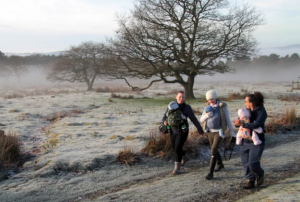
Take your time!
However, doing too much too soon can be unhelpful in the long run, for your body's recovery from birth. Every mother's body is different, and your level of fitness before and during pregnancy will also play a part. Pushing yourself too far too fast can play havoc with wound healing, with slower cessation of bleeding, with prolonged problems with pelvic floor issues, for example. Take your time. There is no need to spring straight back into your pre-birth activities.
Don't fall into the trap of believing that you need to "get your body back as soon as possible." For a mother, the act of bringing life into the world is transformative: your body will never be the same again, and that is a great thing, one to be proud of!
It is good to be fit and healthy, but there is a time for nurturing the new life you have brought into the world, resting and growing together, and a time for weight loss and organised fitness. Simple walking with your baby in a comfy well-fitting carrier and spending time with friends may be all you need for the first few months, for mood lifting and gentle exercise. Does your local sling library organise babywearing walks, or why not start your own?
Points to Consider
If you decide you would like to join fitness or dance or any other classes that have a sling component as it seems a good option for your needs, here are some useful points to consider.
Is your body ready?
- This is very important. Pregnancy and birth have an impact on the core postural and abdominal muscles and the pelvic floor; it takes time for these to recover. Floors may be weak, but they can also be over-tight, both cause problems.
- Overloading still-recovering tissues with certain stretching or weight-bearing activities with the extra weight of a child in a sling (especially if it is poorly fitting or worn low and loose) is not wise, and may end up delaying recovery and causing more long term damage. Wide and deep squats (as opposed to narrow based with vertical shins), side lunges and jumps/bounces, for example, are all inappropriate until pelvic floor function is restored.
- Good posture (with aligned shoulders, pelvis/hips, knees and ankles) matters; many mothers walk with a sway back shape, out of habit or to balance weight of baby, or stand with one hip jutting out. This strains the floor and the core and needs to be addressed.
- Walking with a baby in the sling, ensuring good alignment and posture, gradually increasing the speed and duration, is usually enough exercise for most women in the early months.
- Please do not rush; pelvic floor dysfunction is very, very common (14 million women in the UK are known to have an issue, and many many more never seek help and remain undiagnosed).
- Leaking is NOT normal or to be expected, if you leak with a baby in a sling, on coughing or laughing, you have pelvic floor dysfunction. If you are unsure if your pelvic floor is recovering normally, please see your GP.
Do you have a good carrier to keep your child safe and keep you comfortable?
- As with all things: your sling is never a substitute for alert responsiveness and your focus should always be on your child and their needs. A sling should hold them comfortably and safely with airway protection and neck support (ideally by appropriate seated positioning that meets the TICKS guidelines). Movements should never allow a baby to be shaken, and should always be done with their head and neck position in mind.
- Forward facing out carriers, especially narrow based ones, tend to encourage the baby to lean away from parent, which has an impact on parent's posture, overcompensating for the weight by leaning back. Poor posture can lead to significant health problems.
- It is worth noting that many manufacturer instructions do not recommend exercising with their product; using your carrier for this purpose may invalidate any warranties. Additionally, it is unfortunate that a number of baby carriers are not as well designed as they should be, and their instruction manuals are less than ideal.
Is your baby developmentally ready for this kind of activity?
- Parental activity should never lead to any kind of shaking for children, particularly with young babies whose heads are disproportionally heavy and whose neck muscles are still not fully developed (babies tire very easily as their muscles fatigue).
- Babies should not slump over in the sling during the class and should not fall asleep facing out.
- A good class should respect your baby's development and not include any kind of vigorous repetitive jumping, spinning or shaking movements; your child's safety is the main priority here.
Does the instructor fill you with confidence?
- Does the instructor have appropriate recognised sling training to ensure your baby is kept safe in the sling at all times? It is worth checking, as it shows a good level of preparation and thought.
- Do they know enough about baby anatomy and development and muscle fatigue with certain positions?
- Will they recognise if your child has moved to a position where their airway could be compromised?
- Will they be able to help you correct this (especially if you are not an experienced sling user)?
A good analogy might be a canoe class. If I wanted to attend a class and was required to bring my own life jacket, I might not know which was a reliable brand that would be the most likely to keep me safe. I might ask the advice of a local lifejacket expert, but equally I might buy a cheap one off the internet which has poor instructions that didn't really show me how to keep myself safe or recognise when it wasn't on properly. At the canoe class I would expect that my instructor would be able to give me the once over and check my lifejacket was fit for purpose and on correctly, and would indeed keep me safe, right there and then. I would expect that if my lifejacket began to slip or wasn't in fact on properly during the class, the instructor would be able to identify that and take appropriate measures to remedy this, to keep me safe. I would expect that my instructor would be fully qualified in all aspects of the class - after all I am entrusting my safety to them. Their position of authority means I am more likely to assume that they know what they are talking about, and as a newcomer to canoe classes I will take any advice they offer about the equipment used in the class as expert (even if it isn't).
- Does your instructor have appropriate qualifications to ensure your postnatal body will not be inappropriately overloaded by the extra weight of baby with the movements in the class? If they have recognised post-natal training they will be happy to share this.
- Do they enquire about your overall fitness and pelvic floor health and adapt the routines for your needs? The "six week check" at the GP is not sufficient "sign off" (very few GP's have the time to discuss exercising at the postnatal check, if there is one at all!)
- Do they come across as truly well researched and acting in your best interests?
- Are they taking your and your child's wellbeing as seriously as you do?
- Are they being responsible?
I feel strongly that there are many risks involved in taking part in organised classes for fitness/dance with slings. I would urge all my readers to think very carefully before getting involved with anything that has any kind of vigorous movements such as jumping, bouncing, spinning, and so on. Babies need our loving focus, care and attention; their safety must remain the first priority at all times. Your body's recovery matters too; take your time!
Do speak to your local sling librarian/consultant (Sling Pages has a list) about any classes you are considering before you go - they will be able to advise you on its suitability and help you find a sling that will work well if they feel the class is safe. There are some well-set up and well trained franchises or individual providers who do take their responsibilities towards you and your baby seriously.

Further Reading
This post on Babywearing Exercise is extremely helpful for further reading and should be read by anyone investigating such classes. Thanks to Emma at SlingSure & Fife Sling Library for this.
Positive Effects of Carrying for Baby
Carrying your baby is essential to their normal physical, psychological and neurological development. Human bodies are adapted to be a carrying species, it is part of our evolutionary history, however, our bodies are not as fit or as strong as our nomadic ancestors. It can be hard to carry in arms for prolonged periods of time. Nevertheless, babies need to be held, so a good, safe sling can be very useful in to help with increasing carrying frequency.
Remember, it is the relationship of closeness and loving touch that matters, as well as the position adopted in a good sling. The type of sling or the fabric that you use is just personal preference.
The benefits of babywearing- or the positive effects of carrying for baby are many; here are a few.
The positive effects of babywearing for baby are many; here are a few.
- It encourages bonding with the parent and helps to meets baby’s strong need for a sense of security and attachment, which will lead to greater confidence and independence later in life, as well as greater resilience and better long-term physical health.
- It helps to regulate temperature, heart and respiratory rates, and emotional and physical growth. This can be especially useful for premature babies (the term “kangaroo care” and “fourth trimester” come from this concept) or children who are unwell.
- It promotes and encourages the establishment of a successful breastfeeding relationship, in part due to the oxytocin release from the soft touch. Mothers who carry their children in soft slings are more likely to breastfeed beyond the early weeks.
- Soft touch has many benefits for neurodevelopment and and helping the social brain to form.
- Regular close skin contact is believed to help babies regulate their circadian rhythms better and distinguish the difference between night and day sleep.
It reduces crying, both frequency and duration, (Hunziker and Barr 1986) and can improve sleep. It is safe for your baby to sleep in the sling, if the airway is well protected. Less crying means more time to be in “quiet absorption’, promoting learning and positive interactions with the world. The Esposito study discusses some of the mechanisms behind movement and how carrying is calming for babies.
- Babies with colic can be hard to soothe, but the motion gained from being gently rocked in a sling while the parent/carer walks may help to settle them, and also the parent/carer may feel less helpless. There is no evidence to suggest that babywearing actually reduces colic itself.
- Many parents of reflux babies spend a lot of time holding them upright and have tired arms and sore backs! A good sling that supports an upright position can thus reduce regurgitation and the discomfort of reflux. A spread squat position helps relax puborectalis muscle, to aid bowel elimination.
- The motion experienced by a baby being held by the carer allows the vestibular balance apparatus to develop more rapidly and enhances neuromotor development and muscle strength. It improves neck and head control, but is not a true substitute for “tummy-time” (tummy-time head-lifting is against gravity from a prone position). This is more marked with dynamic in-arms carrying (where this is possible). A sling or carrier should never be used as a prolonged restraint (unless danger is present such as crossing the road).
- Children should always be encouraged to be active as much as possible (WHO 2019) and if they want to get down and it is safe and practical to do so, this is ideal. However, this doesn’t mean that a child who is otherwise very active needs to be automatically removed from the sling after a certain amount of time. Sleeping babies do not need to be disturbed, just gently adjusted to ensure safety.
- It is believed to encourage sociability and language development; being able to hear the parent’s voice close up and watch their interactions with the world and other people from a higher vantage point is beneficial and also aids formation of family relationships. Studies into reduced talking in outward facing buggies highlights the importance of children being able to communicate easily with their carers.
- It allows baby to retreat from an overwhelming world and snuggle into the parent’s body for respite when needed. This is harder to do with world-facing carries, so encouraging parental responsiveness with front-facing out positions is important. (The challenges of facing forwards is covered in more depth here)
- Babies can learn very easily from a place of consistent safety, as their brains are not engaged with mere survival.
- Good, correctly designed slings that encourage the physiological spread-squat "M shape" position (that mimics hip-perching) can help prevent hip problems later in life in those children at risk of hip dysplasia. There is currently no convincing evidence that narrower based carriers cause hip dysplasia in otherwise healthy hips.
- Babies who are carried are less at risk of plagiocephaly (the flattening of the skull bones at the back of the head from prolonged periods lying on the back, more common since the “Back to Sleep” campaign). Slings are recommended as one solution (by the NHS, too!)
Further reading
"Why Babywearing Matters", Rosie Knowles, 2016
To have and to hold: Effects of physical contact on infants and their caregivers, Infant Behavior and Development, Volume 61, November 2020
Read some more articles about why carrying and using slings are good for babies below
Attachment, Babies and Carrying (HuffPost)
Secure Attachment and the Fourth Trimester
Adverse Childhood Events and building resilience in children
Seven Reasons to Carry your Baby (HuffPost)
Why Carrying Matters (Juno Magazine)
If you would like to read in more depth on this subject, my book “Why Babywearing Matters” discusses much of the evidence base for the importance of carrying. It is normal behaviour for the human species to carry their infants close to their bodies; the book considers the anthropological, physiological and psychological reasons for this. Carrying really matters.
Blog
The Carrying Matters blog page.. enjoy reading! If you have any topics you'd like to see covered, get in touch! I enjoy writing and am always keen to hear of new ideas, and to host guest blog posts too!
Can I carry my baby in a sling if I have epilepsy?
16th November 2017
Guest Blog from a friend of mine about her choice to use a sling to keep her child close despite her diagnosis of epilepsy. It has worked out very well for her. Here she discusses the processes of…
Breast and Bottle Feeding Safely in a Sling
5th August 2017
I meet a lot of pregnant ladies in the course of my varied roles, and many new mums, and one of the questions I am most frequently asked is "Will I be able to feed my baby in a sling?" It's an…
The Fuss about Facing Out

What are the advantages of world-facing?
Babies do enjoy seeing the world, especially once they are a little older and have mastered head control and wish to be more involved with their environment, rather than sleeping or snuggling in as they did when they were very little. Curiosity often coincides with increased motor co-ordination and greater periods of awake and interaction time. This is often the point at which families begin holding their babies in positions that give them greater visibility. Instinctively, they tend to support their little ones in very gentle positions that still ensure good hip and spine support; cradled in arms with chin off chest, or held in semi-seated positions with back curved against parent but hips held in flexion, as if sitting in a bowl.
These positions protect the natural anatomical curve of the immature spine and do not straighten it uncomfortably.
As babies grow, their muscle strength increases and fatiguability decreases, alongside greater coordination and gross motor skills. This allows slowly improving head and neck and upper back control (with less drooping or wild flailing) as their spines gradually begin to uncurl. Furthermore, as their focal length improves and visual acuity rises, the world becomes very interesting! There are stages in baby development when babies seem to arch away in arms a lot; this may be related to a desire to see more, but may also simply be attempts to hone upper back strength, in preparation for turning skills and rolling over. This is very common around ten to twelve weeks. Babies may also arch when they are tired, if they have reflux, if they are frustrated.
In-arms holding is responsive, which is the key issue; if baby makes a protesting movement or noise, the carer responds and moves the baby to help it to become calm again. Also, parental arms get tired and baby is easily moved to another position, this may often be on the shoulder facing parent again for a while. Such reactive carrying in-arms, with changing facing-in and facing-out positions, is of great benefit for honing development and also to encourage learning about the world from a safe and comfortable position.
This all sounds great, so what’s the problem with using a sling for this?
What are the hazards of facing out?
It is important to remember that young babies are not ready for prolonged and intense interaction with a very sensory-overloading environment; they have not yet learned how to process the bombardment of information their brains are receiving. They have not yet discovered how to “filter out” the irrelevant for a more focused look at the world, (a skill that we take for granted) so this can be very tiring. Being able to turn away from the noise and bustle and fall asleep (to process information) is important. Babies should NOT sleep facing out.
A facing-out carrier holds a baby in a fixed position for a prolonged period of time. The duration of this time is entirely dependent on the parent; they are unable to see their baby’s face to pick up early cues of tiredness or distress or breathing difficulties, and they are less able to feel subtle shifts in baby’s body signalling discomfort or a need to change positions. Babies can easily be left in carriers for much longer than they would be held in arms.
Babies are intensely social creatures and learn to regulate and control their emotions from interaction with their parents and watching their faces. Social referencing (also known as triangulation) is very important in the first year and well into the second. A child will often decide how to react to a new experience after it has looked to its carer; it will be less likely to touch something dangerous if the carer reacts in an upset way. Potentially scary experiences can defused by turning the head to see a parent remaining calm, or to receive comfort and reassurance, and vice versa. In a structured carrier worn facing out, it isn’t as easy for a baby to twist around to see the parent’s face for reassurance or to be able to seek comfort.
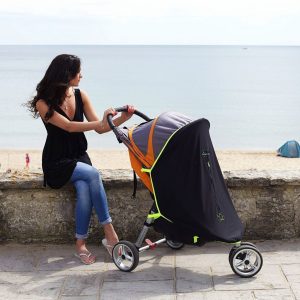
Furthermore, the world-facing positions do not provide any safe sleeping positions (all respected manufacturers say babies must be turned around to sleep; this is often missed in the small print) as there is no head support in this carry. A heavy head that is unsupported by a parent’s chest will droop forwards, putting baby’s chest under slight compression and pressing the chin downwards, potentially compromising the airway.
This is why the majority of respected sling manufacturers suggest that babies under 4months should not be carried facing out. Before this, babies simply are not developmentally ready. Beyond this age, they should not be held in carriers facing the world for longer than twenty minutes to half an hour or so. (Some manufacturers say facing out from 3 months up, some say from 5months up). I think it depends on the child’s personal developmental stage and there should really be no rush.)
There is also the issue of hip and spine positioning in facing out positions. Most facing out in slings is done with “narrow-based” carriers, as very few high street options offer wider, more ergonomic seats that protect the gentle curve of the spine and promote healthy hip development in the world facing position. Most babies find their backs are held in straighter positions than ideal, with their legs hanging straight down from their hip sockets in this narrow shaping. While there is no formal evidence that choosing a narrow-based carrier will cause any harm to a baby who has healthy hips with normal sockets, there is a small percentage of babies who do have developmental hip dysplasia that are missed at their routine checks. These babies will benefit enormously from the ergonomic seated M shape position that allows their joints to be held in the optimum angles for healthy blood vessel growth and nutrient provision, and often this positioning is all that is needed to correct mild cases of hip dysplasia. It is worth weighing up the risks and may be better to choose a carrier that holds a baby more optimally if you decide to face baby out. Additionally, it is more comfortable for a person to be seated on a broad based hammock shaped chair rather than perched astride a narrow padded beam, and babies are no different.
Carrying a baby who is sitting high up against the carer’s body with the centres of gravity closely aligned is much more comfortable than carrying one who is low down, far away, and suspended from the carer’s shoulders. The parent’s body does not form part of the support structure of the carry when facing out, so much of the work of carrying has to be done by the upper body, rather than the core postural muscles. Centres of gravity diverge further when held facing out in narrow based carriers. Put simply, carrying facing out in this style of carrier is often uncomfortable.
Ok, so what can I use to carry my curious child optimally?
It is common among parents who are considering using a sling to look for options that offer world-facing positions. This position is what is often seen in the media and is widely advertised; it may be more pleasing to see happy babies looking directly at the camera rather than away from it, which can be better for marketing purposes. As it is so visible, it becomes the “norm” and carriers that offer this option are often perceived as “better.”
Many parents believe that babies need to be given the opportunity to face the world as much as possible for the stimulation, rather than looking at their parent all the time. Sometimes this belief can be be a marker for low self-esteem in a parent; that they just aren’t interesting enough, when in fact, for many well-attached babies, their parent is their most beloved sight. This is especially true if parent and baby are attuned and the parent is responsive and communicative and able to engage happily in play with their baby. Babies are often able to pick up on unhappy or uneasy feelings in parents and can be reflexively resistant to close contact, creating a negative spiral. Lots of in-arms carrying, skin to skin, and just time spent together can be very helpful with this.
Sometimes babies may begin to resist being carried in their parent-facing positions – they may have come to associate the sling with sleeping which they don’t want to do, and they may want to be able to see more.
To achieve a good view while the child remains parent-facing, and ensure access to the world, try carriers with broadly angled straps that don’t get too close to the face can be very useful, or ones that can be tied carefully for good visibility. As children grow in co-ordination, they need less head support and often enjoy having their arms out of carriers (with the panel reaching up to the armpits for safety and support.) It is surprising how far a child can turn round to see when they can move their shoulders! 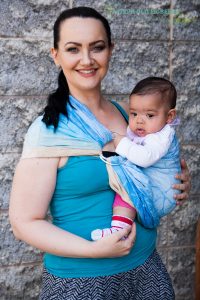
If you have a baby who is developmentally ready for facing out in a carrier and has stable hips, then I think it is just fine to give it a go! Your local sling library will be able to show you some options and talk you through which may be the most comfortable for you. Trying the carrier out first for a period of time at home is very useful to see if it really does work for you before you buy; advice from the internet is no substitute for real life trials.This period of “fussiness” doesn’t usually last long, as babies grow in co-ordination they are happier and many babies who once resisted facing in are very content a few months later in a carrier that is more comfortable with greater longevity.
In summary, facing out can be a great deal of fun for parent and child, if done sensitively and thoughtfully, with consideration to the child’s anatomical development and comfort; look for those carriers that take your baby’s comfort as seriously as yours. Try to pick a carrier that will hold baby optimally for most of the time, some come with specially designed bucket seats and others will widen for facing in and back carrying.
Age-appropriate facing out for those who enjoy it is great, when done safely! Your local sling library can be found at www.slingpages.co.uk.
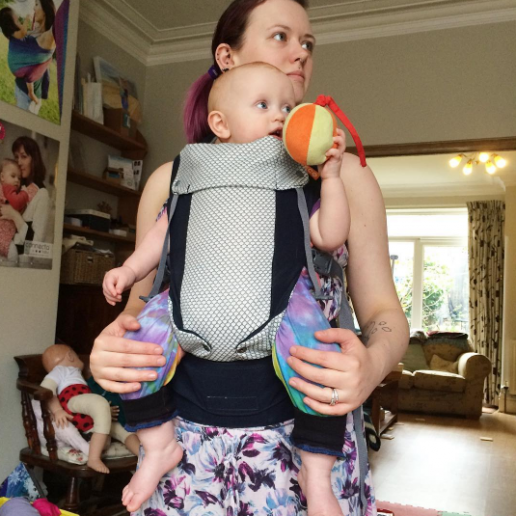
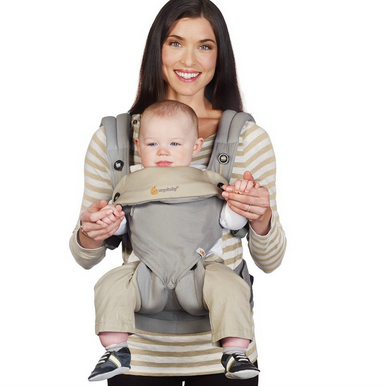
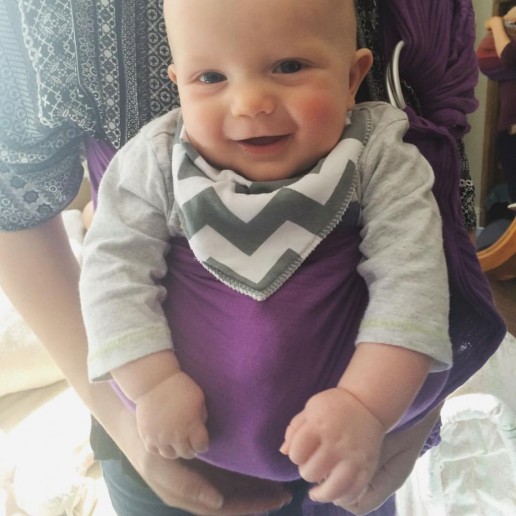
Babywearing in Ramadan
Nafeesa tells us about Ramadan and her experiences of babywearing during this holy month.
Parenting isn’t always easy. A poorly child who wants nothing more than cuddles, a grumpy child who for whatever reason cannot be consoled, a parent who is feeling touched out or is sleep deprived may not necessarily feel like having the responsibility of parenting that particular day. We all have challenging days as parents and it is part and parcel of the family narrative that we create.
Now imagine if you were having a challenging time but you were not eating or drinking all day, particularly in the summer? Or you were trying to console a sad child knowing full well you desperately needed them to settle so you could catch some quiet spiritual contemplation? Such is the life of a Muslim parent. Since the end of May this year (2017), Muslims all around the world (including those in Sheffield) have been observing the holy month of Ramadan and without a doubt these will have been issues that have cropped up during this time.
For most people who are not Muslim, Ramadan is automatically associated simply with not eating or drinking. However, in fact it is about much more than simple fasting. Whilst fasting is expected for every Muslim who is physically capable to do so – it is only one component of a month that brings in spiritual gain in generous amounts. For Muslims, Ramadan is a time to spiritually check in, audit our souls and put plans in place on how to be the best people we can be in the year beyond. It’s for this reason that we love Ramadan so much. It’s our chance to reap good deeds.
Unfortunately parents of small children find themselves having to juggle the needs of their children with their own spiritual needs and many parents, including myself, wish we had the extra time to engage in Ramadan more effectively. In my experience using a sling can really help. As a mother of three, including a 5 month old baby, having a sling on hand has ensured I’ve been able to work a little more effectively at getting jobs done quickly so I can engage more time in ibadah (worship). It means that my little one can be kept more calm during “the witching hour” while I tend to my other two, and get iftar (the meal which we break our fast with) ready on the table.
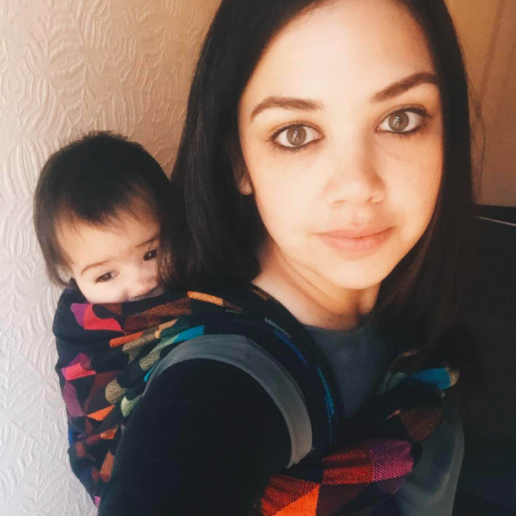
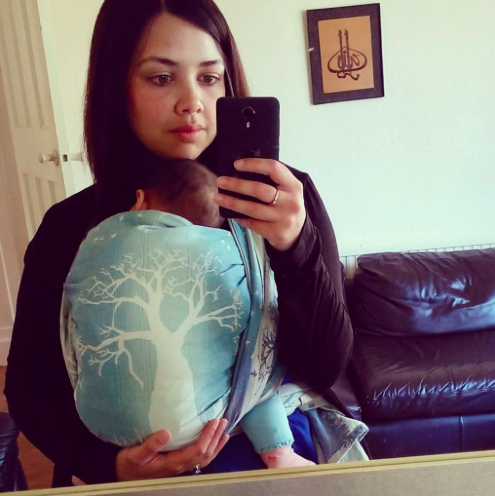
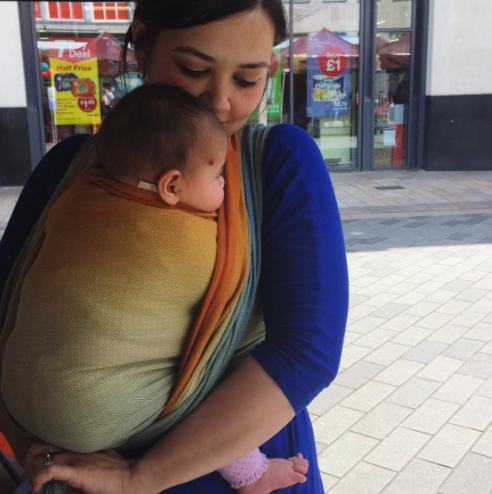
Four years ago, I found myself fasting in the summer months with my two year old (as an aside, Ramadan does not always fall during the summer, but currently is and will be for the next couple of years). I have a very fond memory of walking 2 miles with a heavy toddler in tow on my back on a hot summer’s day. I remember looking at my watch at 2.30pm thinking “I have seven more hours of this to go” (fasting).
It would be easy for anyone to read that and immediate feel sorry for me or think I’m mad for inflicting difficulty on myself for my conviction. One of the biggest micro-aggressions Muslims face are well meaning but ill-informed comments of pity for our choice to fast. The fact is that all who are physically capable of doing so are expected to fast, but there is an element of choice for those for whom it may be too debilitating (for example, with medical conditions, while pregnant or breastfeeding).
Fasting is a physical endurance that gives me the opportunity to cleanse my insides both physically and spiritually.
Fasting and babywearing do not need to be mutually exclusive and ultimately it is no one’s call but the fasting parent’s to determine what they can and can’t do. Ultimately Ramadan is a relationship of deep connection between the individual and their Creator. It’s not my place, your place or anyone else’s to advise a fasting person what they should do.
I chose to babywear four years ago while fasting, as I felt well enough to do so, I did not feel faint and I knew I could keep my children safe that way. This year, as I’m exclusively breastfeeding a small baby, I took the decision not to fast.
Babywearing is an amazing way to share the joy of Ramadan with our little ones. Even if no words are spoken, Ramadan is an opportunity to reap good deeds and build connections. I have enjoyed carrying my baby girl everywhere, speaking and meeting new people, sharing iftar and attending prayers while having my little partner in tow, and now celebrating Eid-al-Fitr with my loved ones.
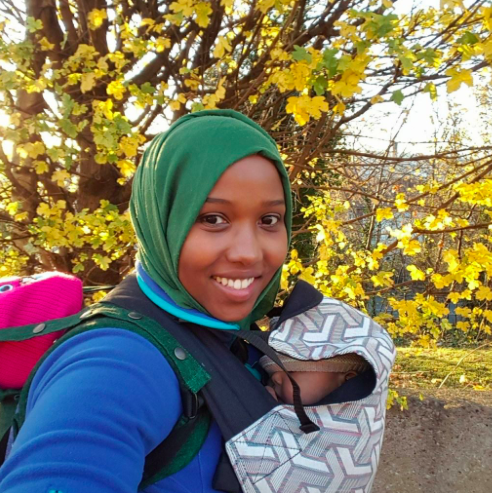
Perinatal Mood Disorders and Carrying
The prevalence of Perinatal Mood Disorders (pre and post-natal depression, anxiety and post-traumatic stress disorder) is increasing in Western society as it is increasingly fractured and isolated, with a decreased sense of local community and shared care. The birth of a baby is often an overwhelming time for both parents, especially when also faced with the expectations and demands of a fast-paced culture that often judges people by their apparent productivity and appearance. As a GP, I see many families struggling with these conditions that are often diagnosed, and keeping babies close may play a part in surviving these illness, mainly due to the closeness with your child, rather than the choice of sling.
Postnatal depression is on the rise – affecting at least 10-15% of new mothers (with many more sufferers (and fathers) never being recognised to have the condition). Anxiety and PTSD are also worryingly common. Parents are encouraged to put their babies down as much as possible and regain their old lives; babies are expected to learn independence as quickly as possible and stop relying on their parents for their every need.
This approach to caring for children is very new in human history and runs counter to attachment theory, which suggests that the human infant thrives on responsive parenting and close contact.
Read about Ruth’s experience of antenatal depression here; for the rest of this post we will focus mainly on postnatal depression (PND).
What is Postnatal Depression?
Postnatal Depression is a depressive illness which affects between 10 to 15% of new mothers. Many more are never diagnosed with this condition, which can become a very significant issue in the functioning of a family. It is often poorly managed by health care providers, and can be misunderstood by the community and dismissed as “just the baby blues” or “tiredness.” It is common for sufferers to feel very alone and unable to explain just how they feel and why it is so difficult to endure. Prenatal depression is also experienced by many new parents, and postnatal anxiety and Post Traumatic Stress Disorder are also commonly experienced pre and postnatally.
Why is it so common?
Western society is increasingly fractured and isolated, with a decreased sense of local community and shared care. Depression is common in our culture, for reasons not clearly understood, but partly due to the way we live. The birth of a baby is often an overwhelming time for both parents, especially when also faced with the expectations and demands of a fast-paced culture that often judges people by their apparent productivity and appearance.
Before parenthood, people’s identities are often based on their roles and responsibilities in life; work, friendship circles, hobbies and interests. After a baby arrives, this often changes dramatically, sometimes in unexpected ways, and for many, the huge change in the pace of life and the loss of control can be very difficult to deal with. “The burden of conscious responsibility with no let up and the unusual and unexpected degree of fatigue can make a mother feel desperate about whether she can survive and how she will manage.” (Kennell & Klaus) This is the role that community used to play; supporting and carrying each other’s burdens as part of a committed and close-knit group of people who lived together, an experience that few parents enjoy in the West today.
What does it feel like?
Common words used to describe PND are guilt and inadequacy.
“The worst part was the guilt I felt about crying every day when I had a beautiful new daughter.”
“It isn’t about not loving your baby but about feeling overwhelmed with responsibility and unable to cope.”
“My head can feel empty and I have no thoughts.”
“It is just so hard to face another day of feeling totally unlike myself, missing my old life, unable to enjoy this new one.”
Fathers suffer from depression after birth too.
“The first few weeks were the hardest and I would just sit and cry. I felt like this shouldn’t happen to me, I should just be taking it on the chin and getting on with it. But the truth is, I felt alone and without the support of my wife, I would’ve been a lot worse.”
Many parents with PND feel a sense of dissociation and detachment from the child they want to love so much.
“It isn’t about not loving your baby but about feeling overwhelmed with responsibility and unable to cope.”
Caring for people with PND is hard.
“PND is the scariest and loneliest place on the planet and puts a terrible strain on the whole family.”
“My husband felt helpless because he knew something was wrong but I wouldn’t admit it and shut him out. All he could do was try to look after me and be there when I finally admitted it. It caused a lot of irrational arguments.”
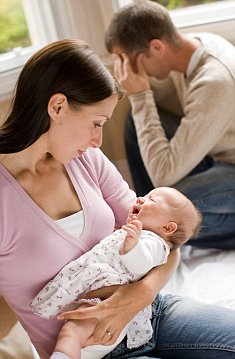
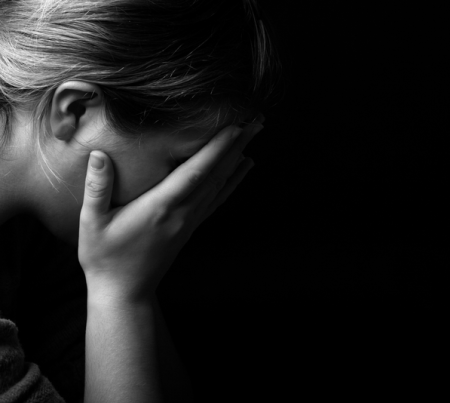
What can I do?
If you are suffering, or think you may be suffering from perinatal mood disorders, first be reassured that you are not alone and the vast majority of people with it survive with few long-term ill effects.
Here are some suggestions that may help.
Get help where you are.
Tell your nearest and dearest how you really feel.
“I found the hardest bit was to admit that I wasn’t coping, even when it looked like I was, I was fine on the outside but was a complete mess on the inside.”
Many women testify how supportive their partners and families and close friends are once they understand – ask them to help with the basic jobs of daily life; cooking, cleaning etc. Help them to see how useful you will find it when they listen to you with acceptance and without judgement, and how their understanding when things go wrong is vital. Guilt is a large part of PND and many kind people may inadvertently add to this burden.
Get help from your local health care providers.
This may be your GP, your midwife, your health visitor, your local SureStart centre. The quality of care from these resources can vary enormously. It can help to write down on paper how you feel in advance and what you think you need (validation, formal counselling, CBT or medication, for example) and take it with you to appointments. Continuity of care is great, if available; a HCP who listens and cares can make a greater difference than one who fires questions and is keen to tick boxes and prescribe medication at once.
“Guilt and lack of confidence are so typical of PND and my HCP was essentially validating those feelings even though objectively I was doing a great job!”
Be armed with information (e.g. if you wish to carry breastfeeding, sertraline is safe in these circumstances). The Breastfeeding Network is a valuable resource. If you are not satisfied with the care you are receiving, find different care.
Get help from your local non-NHS resources.
These can be very useful, such as HomeStart (a befriending service) and local PND groups. A postnatal doula may help, and there are many national helplines and resources (see below)
Get help from online social resources.
There are many forums and parenting groups full of people who know how you feel, and will listen and share. Being among people with the same values and parenting beliefs may be a source of great encouragement. Equally, avoid too much time online.
Get out!
It can be very hard to actually get out of the house when struggling with dark thoughts or hopelessness, but it is worth the effort involved. Even a walk down the road is a good start, and encourages release of endorphins (the natural feel-good hormone). Arrange to meet some friends, and ask them to encourage you to come. Try to make a plan for most days, and be kind to yourself if you decide on a pyjama day instead. Try to arrange some time to spend alone with your other half, to remember who you still are, as well as parents.
Get nourishment.
Good quality food, drink, exercise and sleep are vital to your own health and sanity, as are times to enjoy the things you used to. Dress well in bright mood-enhancing colours. You are still a person and your own needs should be met as much as your child’s. Some people make use of night-time carers to allow some much-needed uninterrupted sleep.
Get past your birth story.
For many women, recovering from birth takes a while, especially if it was not the hoped-for experience. The NHS Afterthoughts service and counselling can help if you feel a sense of grief.
Get a sling or carrier.
Keeping your baby physically close is well known to stimulate the release of oxytocin. Oxytocin is a hormone that is closely related to bonding and attachment. It is released during labour and breastfeeding, and, crucially, during skin-to-skin contact and social interaction. It has an important role in encouraging nurturing feelings and a sense of belonging, and reduces anxiety and depression by affecting cortisol release.
Babies who are in close contact with their parents have been shown to have a corresponding higher level of oxytocin than their non-carried counterparts; which subsequently helps to reduce baby’s own stress levels and improve their sense of secure attachment; their needs are met at the point of request. Calmer babies are easier to care for; win/win.
The soft touch of close skin to skin contact reduces the release of cortisol, the stress hormone, via C afferet fibres affecting receptors in the hypothalamic-pituitary-axis. Stroking has been shown to reduce pain responses.
Modern life is fast-paced and for many, constant carrying of ever-growing children can be difficult to achieve, or uncomfortable after the travails of birth. This is where the practice of using a sling, (sometimes known as babywearing) can be of great value. A soft sling that allows you to keep your child close to you, (thereby stimulating the release of oxytocin and reducing cortisol), and helps your baby to relax and sleep in secure comfort may make a huge difference to your life and your feelings and help you to feel that you can cope. Anxiety may settle a little as you know your little one is safe next to you.
“The sling brought us back to an almost pregnant-like state, with him a part of me, listening to one another’s cues. He was calmer for being close to me, which made me feel more confident, which brightened my mood. Leaving the house felt less daunting so I got more exercise and again increased my confidence. I talked to him more, whether he was awake or not, and he became my son rather than a tiny scary stranger.”
“My favourite thing in the whole world, that never fails to calm me or lift my mood has been cuddles with my baby, particularly skin-to-skin. For me, there is no antidepressant like it.”
“When she was in her pram I felt completely removed from her and her world. I was just an accessory, she was a job to do and I was irrelevant. Using a sling finally helped me bond properly with her and made a massive difference to the PND.”
Many slings are extremely comfortable to use, and can be very practical indeed. It is possible to learn how to feed discreetly in a sling, allowing you more flexibility about being out of the house for the day with your baby.
Slings give you and your baby the freedom to be on the move together, rather than feeling stuck; to go out into the world for a walk or go shopping without struggling with the complexities of a pram. Movement and exercise are vital to wellbeing; and using a sling safely can help your body recover from birth and become stronger.
Slings can be beautiful and colour therapy can help to lift the mood. Learning a new skill can be therapeutic, and many parents find a great sense of community among other sling users both locally and online. This can help with feelings of isolation, especially if you have chosen to parent differently from your family or your peers.

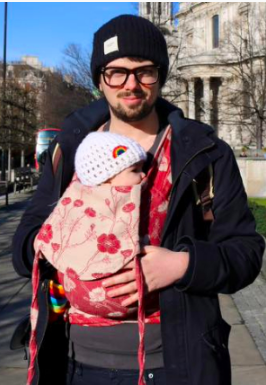
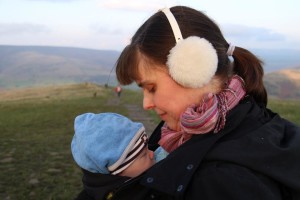
Get a sense of perspective.
What matters in these early months is you and your baby. It does not matter what other people think; the house does not need to be pristine, you do not need to impress people with how well you are taking to parenthood. I have heard many women describe how they “are falling apart on the inside”.
“I thought because I wasn’t suicidal or not looking after things that it couldn’t be PND so held back for a long time from accepting it and getting help.”
“I found the hardest bit was to admit that I wasn’t coping, even when it looked like I was, I looked fine on the outside but was a complete mess on the inside.”
Get confident again.
Reflect on what you have achieved so far and use that to build self-belief. Learn to trust yourself, be an instinctive parent – and you will fin that as you encourage others, you will find yourself lifted too. Some people find going back to work can be very helpful; the chance to use skills again and have adult interactions once more can be a great boost to self-confidence.
Useful Resources
Postnatal Depression Information Leaflet
Postnatal Depression Information Leaflet 2
Pre and Postnatal Depression Advice and Support (PANDAS)
Mothers for Mothers Postnatal Depression Support
Postnatal Illness Information (PNI)
The Impact of Babywearing on Mothers’ Mental Health – Aimee Gourlay
Further Reading
“I carry my heart in a sling” – a blog on how slings helped Lindsay fight her PND.
Sling Sally’s talk on Slings and Sanity for the 2015 Northern Sling Exhibition
Surviving PostNatal Depression – Selina Shaik for MIND
How Carrying Helped My Recovery – Ellie at Peekaboo Slings
Carrying With A Mental Health Disorder – Andrea’s story
Slings and Prams and Guilt
“I have a confession to make. I like my pram; sometimes I choose it over my sling. Does that mean I’m not a real babywearer?”
“I feel guilty if I pick the pram for days out when I know the sling is so beneficial.”
“I feel selfish if I use the buggy, but sometimes my body needs a break.”
Slings and prams and guilt often seem to go hand in hand; as if there wasn’t enough guilt involved in being a parent in the first place.
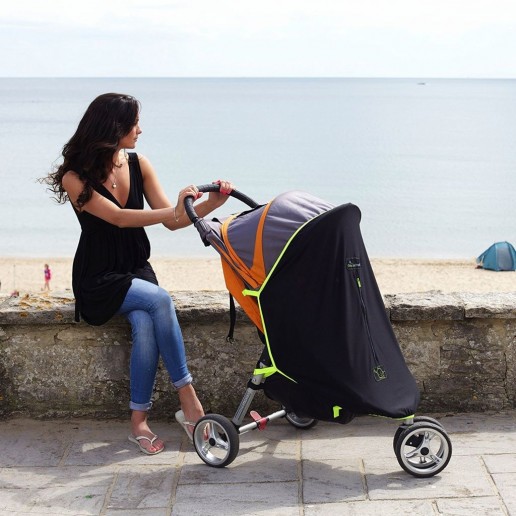
I hear phrases like these from time to time, and while I am delighted that these families have discovered the good things that come from using a carrier, I feel sad that guilt has started to creep in, and that divisions are developing. There is more than enough guilt in the world for parents; how they choose to feed, how they choose to dress their children, and now it seems, how they choose (or don’t choose) to carry. I am really keen to prevent any “mommy wars” regarding carrying from springing into life, so here are my answers to this sort of situation.
Carrying DOES matter. Carrying your child is an important and necessary part of the “fourth trimester” early months of life, it is part of the essential bonding (imprinting) process whereby attachment is created. Secure attachments with a loving caregiver are the bedrock of future positive mental health and the springboard into healthy emotional relationships in later life. For young babies, loving touch and holding are one of the major means of providing this sense of being loved and being secure. Few of us are able to resist the urge to hold our crying children, to provide them with relief and to be their safe space, it is instinctive in us. We should all spend a lot of time holding and loving our babies and allowing them to learn to love us back.
However, modern life is demanding and society encourages us to think that early independence is desirable; that children should not “hold us back.” It is important to care for all members of the family; baby, siblings and parents equally; and this is where using a sling can help. A baby needs to be carried; a sling will allow this to happen while life can continue around them. A sling can mean the childcare can be shared with other adults, a sling will allow a parent to get out and around without the need for lots of equipment.
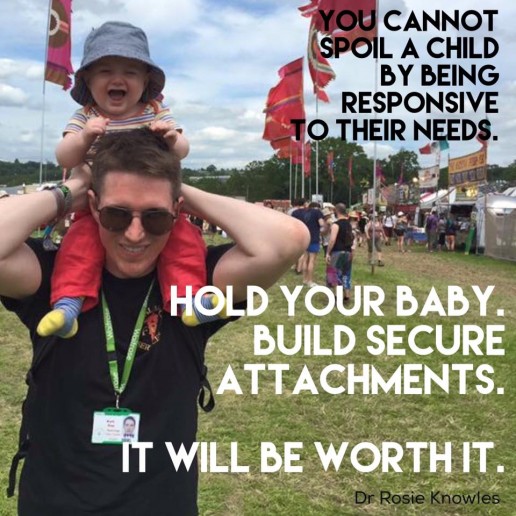
That said, there are many ways to keep a child close without the need to use a sling 24 hours a day. In-arms carrying, cuddly play, breastfeeding, bedsharing, piggybacks, reading stories with baby on your knee and so on are all ways to be in close contact. It is indeed vital to keep up with regular close contact well into the 2nd year and beyond as our children’s brains are still learning about love and attachment – it’s an investment in their future mental health. However, once babies begin to take control of their own bodies and learn how to move they need the freedom to do so.
Prams and buggies are a perfectly valid, convenient and useful way of transporting your child around and there is no reason to feel you are disadvantaging your child by using one instead of the sling today, or depriving her of something, especially if she can see you and remain in communication. You can meet her needs for closeness some other way later in the day. There is no reason to “ditch” the pram if you find it helps you in your parenting. A pram is (like the sling) a tool for getting around and carrying things, and may be easier in many circumstances, just as a sling can be easier in others (eg public transport, busy shops, off-road exploring). There are many ways to carry other things when your baby wants to be up; special bags that fit around the sling.. or a buggy!! Many families use and love both types of transportation, choosing what will suit the situation best.
Some children may just prefer the space of the pram; this is not a rejection of you, but may just be an expression of their personalities or their wish to explore what they can do with their limbs. It may be that your little boy feels too hot in the carrier that you have, or just fancies a change! Your toddler may also enjoy being able to see the world from a different perspective. If your baby loves the pram and doesn’t want to go in the sling today (assuming of course it is a comfortable and well fitting one – see here if your baby seems to hate the sling), that’s just fine. You are being responsive to your child; there is nothing to feel guilty about.
Sometimes YOU may just prefer the pram over the sling, especially if you are feeling a little claustrophobic or touched out, or just tired. Maybe you have two children, or more, and the buggies are the best option!
We don’t live in the same supportive communities these days and it can be hard for one (or two) people to shoulder the load of responsive parenting alone 24hours a day, we all need a break sometimes. “Villages” of old would share the carrying/ feeding/ entertainment more widely, which provided a much better balance of life than many of us are able to find today. If you want to use your buggy, use it and enjoy it, you can cuddle your baby later (or you may have already used the sling today.) Do not feel guilty that you are not being the best parent that you could be.
Do not feel guilty if you feel you just can’t carry today. There is no such thing as a perfect parent and social media sharing doesn’t present a true picture of people’s lives; it can look like others are using their carriers hour in hour out, day after day from their photos, but these don’t show the in between hours or days where the sling is not in use (and the pram is!) Sometimes prams are an expression of our personalities too, just as the carriers we choose can be…
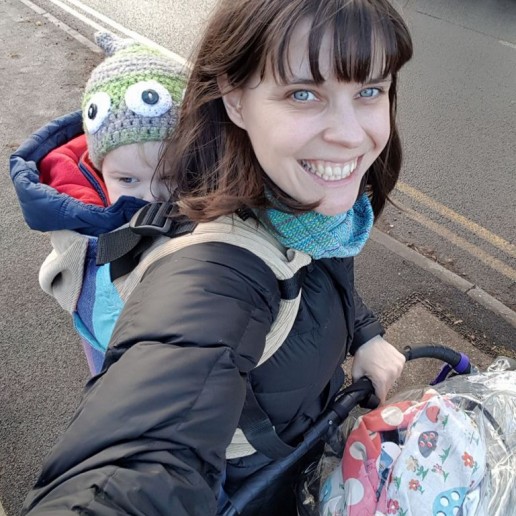
All safe and responsive carrying is good
; the sling you choose to use is not important, as long as it is safe and comfortable. A buckle carrier is as valuable as a mei tai or a woven wrap or stretchy or a ring sling. Even brands of buckle or wrap is irrelevant; what matters is that you and your child are together, in close contact, safe, and enjoying each other’s company, or sleeping in contentment.
If you are a sling user, this is a great opportunity to avoid creating a culture of guilt and judgement. The parents you see using a pram to quieten a crying baby may well have found this works better for sleeping than their sling. The mum you see pushing a pram in crowds may feel her baby is safer inside the pram than being bashed by passers by in a sling. A parent carrying a heavy toddler in their arms after a melt-down may well have chosen not to use their sling today. iIt is important to be kind and recognise that one moment is not a whole life, and we do each other a dis-service if we unintentionally spread the message that either prams or slings are superior, or if we stare and make comments about others that could be overheard. All safe slings are of great value, and we should be cautious about what message we send to the new parents around us.
I’ll finish by reiterating that carrying IS important. We should all carry our babies and spend as much time in close contact with them as we can, be that in a sling, in arms, hand holding and so on. We should try to carry our children as much as possible, as there are many good reasons to do so. That does not mean that we should feel guilty if we choose to use prams or buggies as well, or if we choose to use one kind of sling over the other.
Oh, and of course it is fine to come to a sling meet/sling library session with your pram! And no, you definitely don’t need to feel embarrassed if you see me out and about and you are using your buggy!
Why Carrying Children Matters
Why does carrying matter? There are so many reasons why holding and carrying children matters, on multiple levels (biological, developmental, psychological, sociological, long term health) that it would take a whole book to discuss, even in brief!
Carrying behaviour is normal for the human species; babies are very vulnerable at birth. They are born with great needs, there are many months and even years of maturation needed before human infants are able to control their bodies fully and become able to care for themselves independently. Babies and young children are dependent on their primary caregivers for a very long time. This prolonged childhood is thought to be one of the reasons why the human species has been so successful; allowing the human brain to develop complex skills such as language, creativity and the ability to alter the environment around them.
Mothers’ and babies’ bodies are adapted to each other; during pregnancy, during birth, and during the early years. They “fit together” and create a very special shared space, honed over the millennia of evolutionary processes. They work perfectly in harmony, when given the support and freedom to do so.
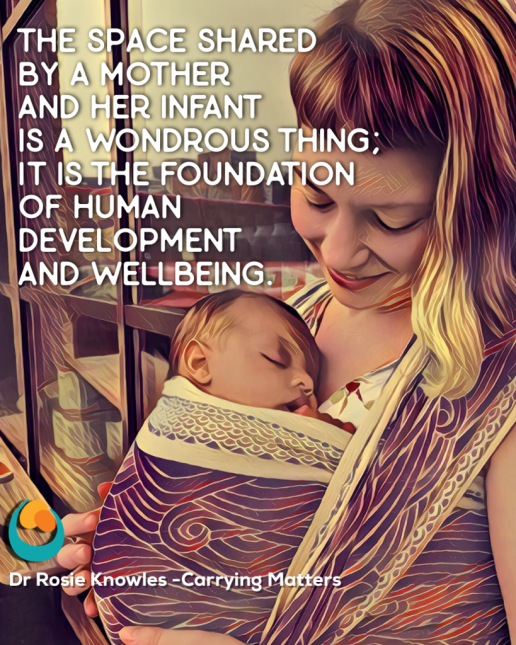
This is where the “4th Trimester” concept comes from; holding and carrying babies recreates in some part the intra-uterine environment of warmth and safety and containment and allows them to develop new skills from this platform of security. Our human instincts are strong (a baby’s cry tugs at our heartstrings and we feel the urge to gather them up, hold them close and rock gently while murmuring in a soothing way) and we are discovering much of the neurochemical science behind this normal, natural behaviour. Oxytocin release builds loving connection via multiple pathways. Soft touch has helpful effects on the hypothalamic-pituitary-axis and cortisol production, reducing pain and modulating the stress response. Gentle and responsive parenting builds and reinforces the neural circuitry as it develops in the child, creating a healthy positive inner thought state that affects long term mental health. Furthermore, building this resilience helps to combat the adversity that so many children experience. Early “skin to skin” contact is enormously useful for beginning this process of connection.
Children need loving nurture in the early neonatal period and long beyond this for normal, healthy development. Carrying babies close to an adult’s body, as human beings have evolved to do, is vital for normal physiological and psychological development. Research into the importance of skin to skin contact, soft touch and responsive parenting, as well as a better understanding of disability reinforces this.
I talk about the positive effects of holding, carrying and babywearing, rather than the “benefits” of these practices. The word “benefit” implies an extra thing, an advantage, something that can be added onto what is baseline… but the holding and carrying (however it is done, in arms or a sling) that builds connection is part of normal human development. It is the baseline! It isn’t something that some parents can choose to do to give their child an extra advantage in life. It is what all babies need, like nourishment, warmth, safety. The absence of these loving connections that involve gentle physical touch is harmful to children.
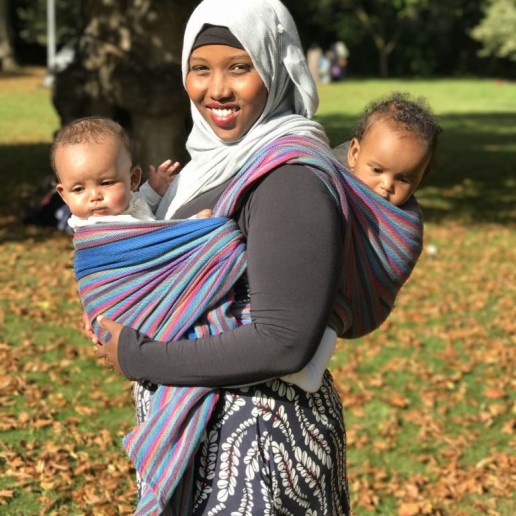
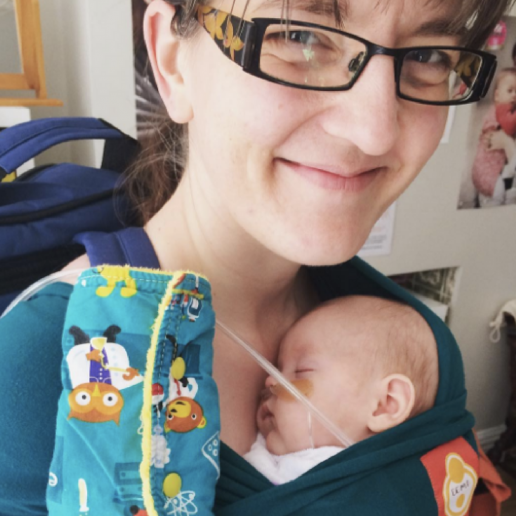
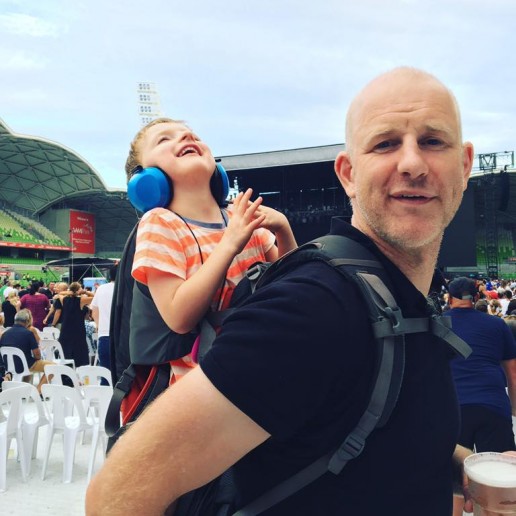
We can agree that carrying children matters. However it is not just babies and children who need the close contact; parents and caregivers also benefit hugely from holding their offspring and interacting with them closely. The same biochemical pathways that help babies and young children to thrive are present in adults too, and families flourish when the needs of all its members are met. Adults need loving contact too; and a child who calms when comforted in arms or a sling provides positive reinforcement that parenting is manageable after all. Many parents find that babywearing can help with low mood and improve their confidence, as well as giving them freedom to get on with their lives in the societal constraints in which they live.
Carrying in arms and in a sling really does make a significant difference to the overall wellbeing and physical and mental health of all members of society, both now and for the future. A society where children’s needs and rights are taken seriously, where knowledge of how to build securely attached children and adults is put into practice, and where the most vulnerable among us are treated with love and kindness, is one in which we would all wish to live. This is why carrying matters; it can change the world around us.
To find out more, please click the links below.

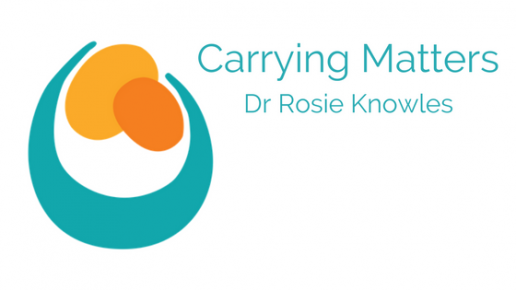
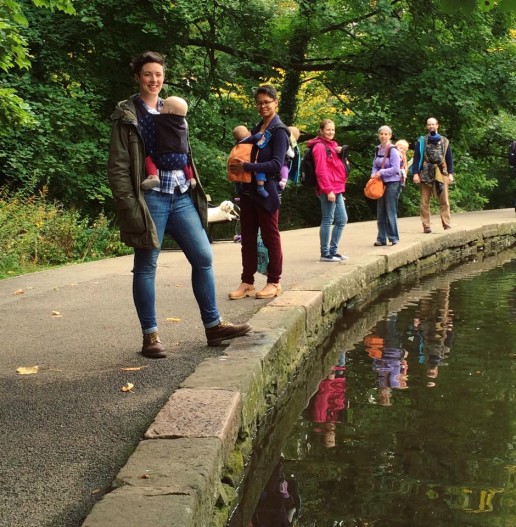

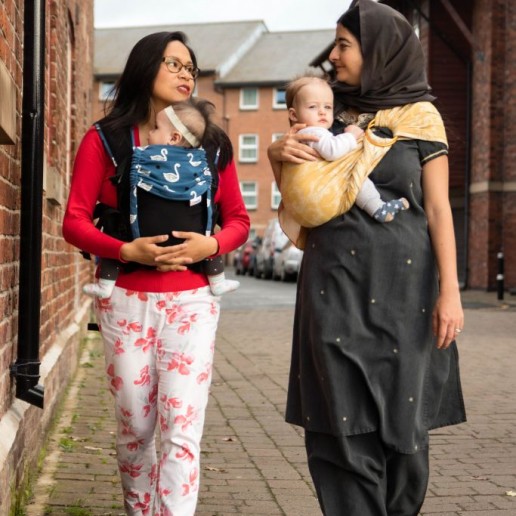
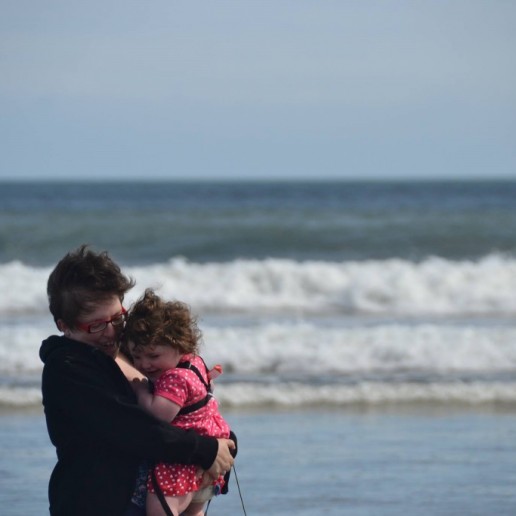
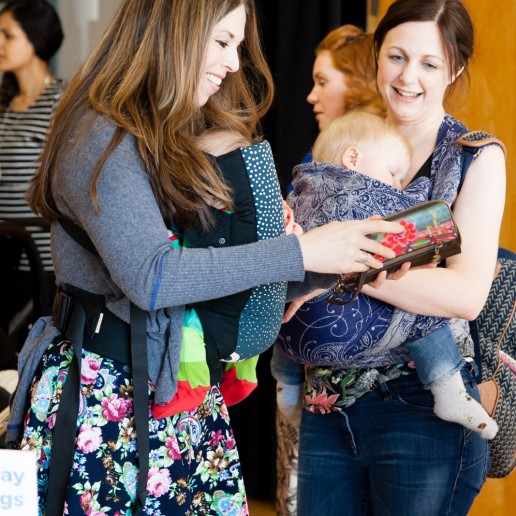

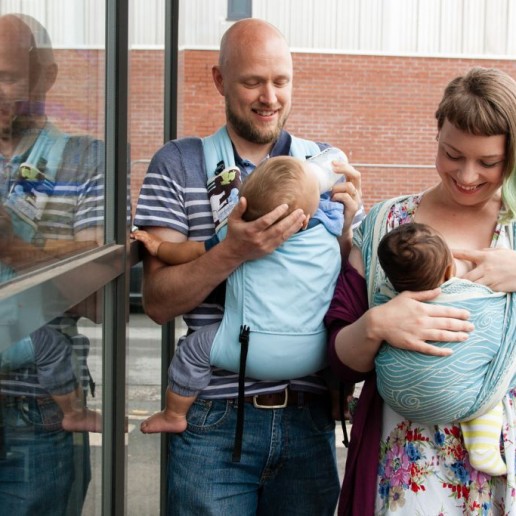
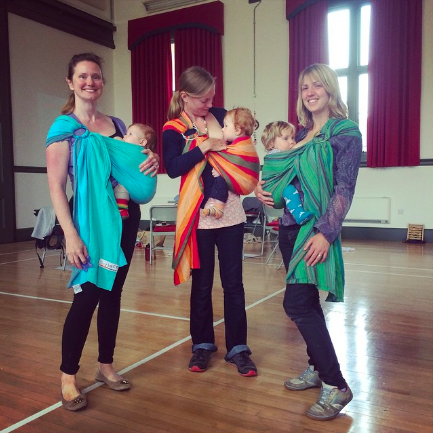

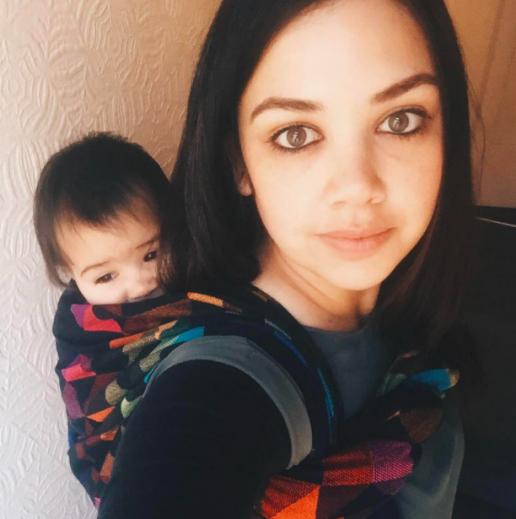

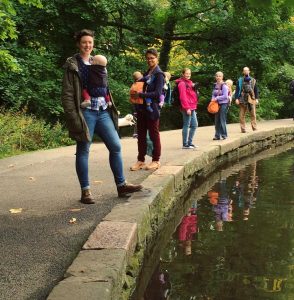 Movement is good for you!
Movement is good for you!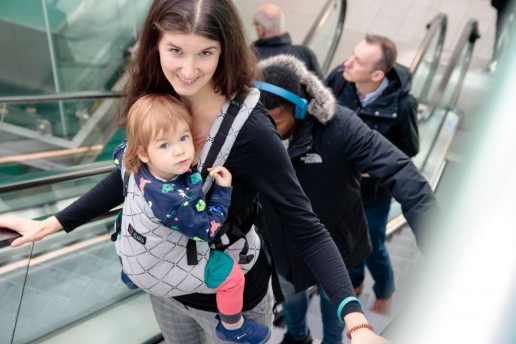
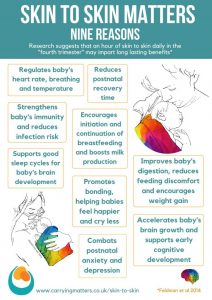 It reduces crying, both frequency and duration, (
It reduces crying, both frequency and duration, (